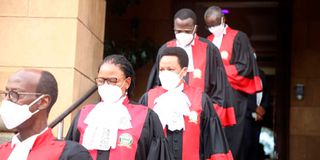Rule against basic structure revives BBI backers’ dreams

Justices Mohamed Ibrahim, Martha Koome, Philomena Mwilu, Smokin Wanjala and Isaac Lenaola at the Supreme Court on March 31, 2022.
What you need to know:
- Six apex court judges said the framers of the Constitution provided enough safeguards for the bedrock of Kenya’s laws.
- A group of activists argued that politicians wanted to interfere with the basic structure of the country’s Constitution.
No part of the Constitution is unamendable, the Supreme Court has ruled, saying there is no space for the basic structure doctrine in Kenya.
Six of the seven apex court judges said the framers of the Constitution provided enough safeguards for the bedrock of Kenya’s laws.
The basic structure doctrine traces its origins to a case filed in India by a monk – Kesavananda Bharati – who said some parts of the Constitution could not be changed.
In opposing constitutional amendments supported by President Uhuru Kenyatta and Orange Democratic Movement leader Raila Odinga, a group of activists led by Dr David Ndii and Mr Jerotich Seii argued that politicians wanted to interfere with the basic structure of the country’s Constitution.
The activists successfully argued that some of the proposals in the Constitution of Kenya (Amendment) Bill, 2020, were a direct attack on untouchable parts of the country’s supreme law.
Justice Mohamed Ibrahim stood alone in saying the basic structure doctrine is applicable in Kenya.
Lopsided constitutional changes
He said the doctrine should be applied to stop the risk of lopsided constitutional changes.
Chief Justice Martha Koome led five other judges in holding that Kenya’s Constitution is not absolute and has enough safeguards against abuse by the political elite.
Justice William Ouko said the High Court and Court of Appeal caused confusion by allowing the implementation of the basic structure doctrine “yet Kenya’s Constitution is self-regulating”.
“In interpreting the Constitution, courts must provide pragmatic solutions without adding confusion to the controversy the parties have brought to them for resolution. The language in Chapter 16 (of the Constitution) is very clear, leaving no room for conjecture,” Justice Ouko said.
According to Justice Smokin Wanjala, the basic structure does not qualify to be called a doctrine. He said it can only be a school of thought not applicable in Kenya.
In ruling out the application of the basic structure doctrine, the Supreme Court has opened the door for anyone – including the Building Bridges Initiative proponents – to restart the push for constitutional amendments.





